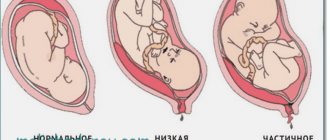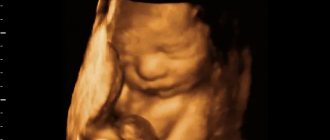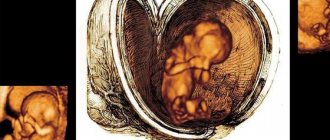Baby movements at 23 weeks
So, you are 23 weeks pregnant. The development of the fetus continues at this stage; in size it already resembles a small eggplant and weighs about half a kilogram. Due to the small amount of brown subcutaneous fat and very thin skin, his face and body are still thin and wrinkled. A baby at the 23rd week of pregnancy behaves very actively, the expectant mother clearly feels his movements and can determine exactly where he is. If the child pushes unusually hard, too often, or, on the contrary, his movements begin to be felt less frequently or disappear altogether, immediately consult your doctor. It will help identify and eliminate the causes of impaired fetal motor activity.
Dopplerography
Very often, an ultrasound examination performed at this time involves studying blood vessels and blood flow. This diagnosis is called doplegraphy. This study is definitely indicated for those patients who have been diagnosed with pathologies, for example, IUGR or decreased fetal growth rates. Indicators that fall within normal limits should have the following values:
- uterine artery index up to 0.38;
- umbilical arteries from 0.6 to 0.8;
- umbilical cord artery ratio from 3.4 to 3.6;
- blood flow speed in the artery is 25.6-27.7 cm/s;
- internal carotid artery 0.94;
- uterine artery 1.95.
The received data is decrypted by a specialist. Don't try to diagnose yourself.
Should the expectant mother's workload be limited?
The 23rd week of pregnancy imposes certain restrictions on the expectant mother’s workload. During this period, you should not lift weights or overexert yourself; it is advisable to use a bandage for pregnant women. Despite the constantly expanding belly, at the 23rd week of pregnancy it is recommended not to reduce physical activity and spend more time in the fresh air to provide the baby with good oxygen nutrition. Fetal hypoxia is a serious problem; to prevent it, you must follow all the recommendations of your doctor and try to avoid stressful situations.
Nutrition
A woman’s nutrition is the basis for a favorable pregnancy. From the mother's body, the fetus takes everything necessary for the formation and development of internal organs. If there are not enough nutrients, then the expectant mother’s body supplies the necessary elements from its own reserves. This directly affects the well-being and health of the pregnant woman. To avoid undesirable consequences, it is advisable for a pregnant woman to be attentive to the foods she eats, the cooking methods and the nutritional component of the diet.
This week it is advisable to increase the number of products containing:
- Iron (organ organs, red meat, pumpkin seeds, egg yolks, apples);
- Calcium (cottage cheese, cheeses, almonds, bananas, broccoli);
- Magnesium (unpolished rice, buckwheat, chicken eggs);
Don't forget about other vitamins and minerals. Ideally, a pregnant woman’s diet should contain:
- Meat;
- Vegetables and fruits;
- Porridge;
- Dried fruits and nuts;
- Wholemeal bread;
- Chicken eggs;
- Dairy products.
It is recommended to follow some rules:
- eat 5-6 times a day in small portions, avoiding mixing different dishes;
- cook food by steaming, oven or boiling;
- Avoid fried, dried, smoked, salted, and highly seasoned foods as much as possible;
- control the amount of salt entering the body. Ideally, a pregnant woman consumes no more than 1 teaspoon of salt per day;
- avoid raw meat and fish, fast food, sausages and frankfurters;
- observe the drinking regime. Unless otherwise prescribed by the gynecologist, a woman needs to drink about 2.5 liters of fluid per day. It is ideal to give preference to clean water.
Vitamins
Taking vitamin complexes and supplements at week 23 should be under the supervision of a gynecologist. It is advisable to carefully follow the instructions and control the dosage. An excess of chemically produced vitamins is just as dangerous as a deficiency.
Constipation is a common problem in pregnant women
At this stage, constipation may become a frequent “guest” in a pregnant woman. Try to eat foods rich in fiber, stay hydrated, and don’t forget about physical activity. Remember that timely cleansing of the intestines is the key to the well-being of the expectant mother. Another trouble that continues to accompany most pregnant women is heartburn and discomfort in the epigastric region. The growing uterus at 23 weeks of pregnancy puts pressure on the organs, and the hydrochloric acid contained in the stomach enters the esophagus and causes a burning sensation.
It is very important for a young mother to take care of her own health and strengthen her immune system, since during this period it is extremely undesirable to suffer from viral and infectious diseases, especially the flu. A child in the womb of a mother with influenza is susceptible to such a dangerous phenomenon as delayed fetal development and various pathologies of the nervous system.
Weight gain at 23 weeks of pregnancy ranges from 3.6 kg (with a BMI of more than 26) to 7.2 kg (with a BMI of less than 19.8). To calculate your individual weight gain at 23 weeks, use the pregnancy weight gain calculator.
Visiting an obstetrician-gynecologist
Often, at the 23rd week, a woman is scheduled to see a gynecologist. On the eve of the appointment, it is necessary to take urine and blood tests (directions were issued at the previous appointment).
Most often, at this time, a woman needs to take not only a general blood test, but also a sugar test. A pregnant woman should remember that for correct indicators it is necessary to undergo the testing procedure on an empty stomach. Many people may experience nausea by this time as a reaction to hunger, so take some food with you to the clinic to refresh yourself immediately after the test.
If you donate blood after a meal, the measurement may be incorrect and your blood sugar may increase. In such a situation, the doctor may prescribe additional tests or suggest hospitalization. One of the complications of late toxicosis is disruption of the endocrine glands (diabetes during pregnancy). Incorrect test results can lead to suspected complications and require unnecessary medical procedures.
At an appointment with a gynecologist at week 23, the following manipulations will be performed:
- blood pressure and body temperature were measured;
- using scales, the woman’s current weight is determined and the kilograms gained during pregnancy are calculated;
- Using a centimeter tape, measure the abdominal circumference to monitor the normal course of pregnancy;
- the height of the uterus was determined (at this stage the highest point of the uterus is 4 cm above the navel);
- The fetal heartbeat was listened to using a stethoscope.
The gynecologist will also evaluate the results of tests taken the day before, conduct a survey about emerging symptoms and new sensations, and, if necessary, provide referrals for additional consultation with specialists. You will be given instructions for tests that need to be taken at your next appointment.
When visiting a gynecologist, a woman should ask all the questions that concern her; for this, it is recommended to prepare in advance. It is ideal to write down questions that arise in a notebook so as not to forget about important things.
Ultrasound

Examination by a doctor at 23 weeks of pregnancy
At the 23rd week of pregnancy, there is no scheduled ultrasound. It is possible to prescribe an additional study if there is doubt on the part of the gynecologist or medical indications.
If desired, a woman can have an ultrasound done for a fee to confirm the favorable course of pregnancy.
Pain in the abdomen and other parts of the body
Pain in different parts of the body at the 23rd week is a frequent accompaniment of pregnancy. A woman is advised to understand the possible causes and know how to behave correctly in such a situation in order to do everything possible to minimize the negative consequences.
Abdominal pain
If you experience abdominal pain in the 23rd week, you should immediately seek medical help. Cramping, cutting, aching, pulling and other painful sensations may be a sign of pregnancy complications or the onset of labor. Urgent diagnosis and monitoring by doctors is necessary.
If a woman feels discomfort, but there is no severe pain, it is advisable to play it safe and consult a gynecologist for advice.
Backache
The increase in belly and weight in the 23rd week of pregnancy causes a shift in the center of gravity (this is why pregnant women acquire a “duckling” gait). As a result of these changes, nagging pain in the back may appear, especially in the late afternoon. The muscles of the spinal column experience tension, which results in pain and discomfort. But this is a normal process, the manifestations of which can be reduced by wearing a prenatal bandage and comfortable shoes with low speed. It will not be possible to completely get rid of unpleasant sensations, but it will reduce their intensity.
If back pain is localized on the sides, has a shooting or aching character, a consultation with a gynecologist and an additional urine test is necessary.
Headache
Most often, headaches at week 23 are caused by:
- surges in blood pressure. This reason requires monitoring by a gynecologist;
- physical fatigue after intense physical exertion. To relieve pain, a woman needs to rest (sleep);
- violation of the drinking regime. Insufficient water in the body reduces nutrition to the brain, resulting in pain. To remove unpleasant sensations, it is advisable to drink clean water;
- lack of sleep. An enlarged belly and increased activity of the baby at night often prevents a woman from getting enough sleep. As a result, headaches may occur. Normal rest (daytime sleep) helps relieve this symptom.
Leg pain, cramps
At the 23rd week, pain in the legs is possible, most often in the calf muscles. Sometimes it’s a nagging pain, sometimes it’s cramps, sometimes it’s an unpleasant sensation. There can be many reasons for such manifestations, so it is recommended to consult a gynecologist for advice.
In addition to the indicated pain, one-time or constant pain and discomfort may occur in the anus (caused by exacerbation or the appearance of hemorrhoids), in the teeth (lack of calcium), in the fingers (edema), in the area of the heart and lungs (compression by the expanding uterus), in right or left side (uterine pressure, incorrect body position). If pain occurs anywhere in the body, a consultation with a gynecologist will not be superfluous. Before using any folk remedies, talk to your doctor.
Discharge
The amount of discharge may increase slightly at week 23. The color of the secretion should be light, milky, and not have a strong unpleasant odor. A woman should be alerted to any change in consistency, smell, or color. If you have any doubts, it is advisable to consult a gynecologist.
Bleeding and menstruation
There should be no bleeding or menstruation this week. Any appearance of blood or red or brown discharge is a reason to urgently seek medical help.
What does a baby look like at 23 weeks of pregnancy?
At 23 weeks, the baby is about the size of an ear of corn.
At week 23, the Baby’s height is about 25-26 cm, and his weight is 400-500 g. At this time:
- The spleen is connected to the work of the hematopoietic organs - the depot where lymphocytes, white blood cells are formed, which perform a protective function in the body;
- The baby is actively moving, and you can already feel his kicks well;
- can occupy any position: vertical and horizontal, moves left and right, up or down;
- The child has noticeable eyebrows.

Ultrasound at 23 weeks of pregnancy
Can a pregnant woman drive a car at 23 weeks?
Babies really enjoy car rides with their mother-driver both before and after birth. The hum of the machine is comparable to the hum of blood flow, the work of internal organs, and the beat of the mother’s heart, which the Baby continuously hears before his birth. The steady rocking of the car, the running of the engine, the calm movements of the mother - all this has a calming effect on the Baby. American pediatrician Julia Orenstein, as one of the ways to calm the Baby in the first months after birth, offers “autotherapy” - driving in a car seat in the evening or even at night, relatively free city streets.
You maintain cleanliness and comfort in your own car by default; you can change the climate control if you wish. However, you should be careful with the heated seat: once it gets warm, turn it off. The flow of blood to the pelvic organs can lead to unpleasant sensations in the lower abdomen and make you worry about your Baby (and this is already stressful). For the little one, heated seats do not pose any particular danger.
As a rule, when driving a car, the mother produces not stress or pleasure hormones, but adrenaline. Unlike catecholamines and endorphins, adrenaline does not penetrate the walls of the placenta, so driving in a mother’s lifestyle can be considered relatively safe for the Baby.
You should be careful in the first trimester, when due to intense hormonal changes, states of inattention, disinhibition, and difficulties with switching attention and holistic perception of the situation on the road arise. The second trimester and the first half of the third are relatively calm. As for the last weeks before birth, there are cases when mothers took themselves to the maternity hospital. This is dangerous, since it is impossible to control contractions, and your behavior on the road will be unpredictable.
Make sure that the belt does not pinch the chest (you must protect the Baby’s future nutrition center!) and the growing belly - it will be uncomfortable for the baby. There are special belt adapters (can be found in auto stores, sometimes in maternity stores) that are physiological for your position.
And, of course, follow the general rules for drivers: if you are unwell or tired, don’t get behind the wheel!
Mother. Changes in the body's condition at 23 weeks

Mom's health at 23 weeks of pregnancy
The 23rd week is a relatively calm period when most pregnant women feel satisfactory and continue to lead an active lifestyle. The belly is getting bigger, but for now it allows you to see your own legs.
The deterioration in concentration is felt more strongly. Forgetfulness and absent-mindedness appear. These are not the most pleasant companions of pregnancy, in some cases they can upset a pregnant woman, so it’s a good idea to take care of various reminders. It's ideal to place sticky notes with important tasks in a visible place or make notes with an audio reminder on your phone. This will allow you not only to complete all the necessary tasks, but to maintain a positive attitude.
Often, at the 23rd week, pregnant women are faced with unpleasant complications and unwanted complications. Some manifestations can spoil a good mood and become harbingers of future problems. Most often this week women complain about:
- dyspepsia. Heartburn, heaviness in the stomach, flatulence and constipation are common phenomena in the second half of pregnancy. Causing unpleasant sensations, and with insufficient attention from the expectant mother, they can cause complications during pregnancy. If symptoms of dyspepsia appear, it is advisable to consult a doctor and pay close attention to your diet. Constipation is a particular danger to the health of a pregnant woman and her fetus. Normally, bowel movements should occur daily. If stool is delayed for more than 3 days, consultation with a gynecologist is necessary.
Certain foods (dried apricots, prunes) and proper drinking regimen help improve bowel movements: you need to consume about 2.5 liters of liquid per day. If diet adjustments do not help relieve constipation, then additional medications may be necessary.
- frequent urination. The fetus increases in size, and along with it the volume of the uterus and the amount of amniotic fluid increase. All together puts pressure on surrounding organs, especially the bladder. The expectant mother begins to go to the toilet more and more often. The most unpleasant sensation is caused by the urge to go to the toilet in the evening, before bed. There may be a feeling of unfinished urination, which does not add joy.
Training the pelvic floor muscles (Kegel exercises) can help reduce the number of trips to the toilet and increase the volume of urine produced at one time. By strengthening the muscles that support the uterus, bladder, rectum and small intestine, a pregnant woman not only helps reduce the number of trips to the toilet, but also trains her body for future childbirth.
To increase the amount of urine released, you can lean forward slightly before urinating, putting additional pressure on the bladder.
If a woman experiences unpleasant sensations during urination: itching, pain in the perineum, an urgent consultation with a gynecologist is necessary. The increasing load on the kidneys often leads to various complications and diseases; the sooner a woman seeks medical help, the higher the likelihood of avoiding undesirable consequences.
- Blood pressure surges. During pregnancy, the amount of blood in a woman's body increases. The body needs to take care of providing oxygen and nutrients not only to the expectant mother, but also to the fetus. Often, as a consequence of this process, pregnant women experience surges in blood pressure. Deterioration in general condition, dizziness, headaches, etc. are frequent companions of low or high blood pressure. If a woman notices the appearance of this symptom, she must tell her gynecologist about it. Very often, pressure surges in the 23rd week are a harbinger of gestosis (late toxicosis), and measures must be taken to reduce the likelihood of its occurrence.
Normally, a pregnant woman's blood pressure should be in the range of 110/70 - 130/90. But every woman is unique, and it is possible to deviate from the given numbers in both directions without significant consequences.
If before pregnancy a woman’s “working” pressure was lower or higher than normal values, then the calculation of the norm at the 23rd week should be based on them. For example, a woman’s normal blood pressure before pregnancy is 100/60. In this case, during her additional attention, an increase in numbers by more than 30 points from the norm (130/90) is required. If before pregnancy a woman’s “working” pressure is 130/90, then indicators above 160/120 should cause concern.
In any case, it is recommended to tell your gynecologist about any changes in blood pressure.
- Edema. One of the most common pathologies of pregnancy is swelling of the hands, feet and face. An increase in the amount of blood in the mother’s body requires the kidneys to work harder. If you have diseases of the urinary system, poor nutrition, or pregnancy complications, the kidneys may not be able to cope with their functions, and excess fluid will accumulate in the body. This is a potentially dangerous condition that may be a sign of late toxicosis. You need to tell your gynecologist about the appearance of edema, even minor ones.
The appearance of gestosis (late toxicosis) without medical control threatens with serious consequences, including death. To avoid serious damage, it is necessary to identify the cause of unwanted symptoms and use all possible methods to minimize them.
- False contractions. At the 23rd week, “frightening” sensations in the abdominal area may appear. Up to several times a day, the abdomen may become hard and a feeling of muscle tension may appear. This is how the body prepares for the upcoming birth. If this phenomenon is not accompanied by pain, then there is no reason to worry. If pain appears in the abdomen or back, urgent medical attention is needed.
In addition to these manifestations of the period, a woman may be worried about other unpleasant features of pregnancy. Anxiety is most often caused by:
- itching in the lower abdomen and the appearance of stretch marks. An increase in the size of the abdomen with low skin elasticity often leads to unpleasant sensations and symptoms. A woman can prevent this process by ensuring that the dermis is sufficiently moisturized in advance. Various natural oils are often used to rub them into the skin or special creams that prevent stretch marks. Before using the cream, it is advisable to consult a gynecologist.
- pregnancy mask. Facial skin pigmentation is a common phenomenon that can ruin the mood of any woman. Dark spots around the lips, eyes, nose, and cheeks are a normal phenomenon caused by hormonal changes. To reduce the intensity of the appearance of age spots and to insure against their increase in size, it is recommended to avoid direct sunlight. During the summer, it is ideal to wear a wide-brimmed hat or use sun cream (check with your gynecologist about this option).
- a pigmented vertical stripe from the navel to the perineum. Often, at the 23rd week, pregnant women discover a dark stripe on their stomach, running strictly vertically from the navel to the pubic area. In some cases, the line may rise all the way to the ribs. This is a normal phenomenon, indicating hormonal changes in the body. For some women, the stripe appears early in pregnancy, for others it appears later, but in any case there is no need to worry about it. After childbirth, the intensity of the color of this stripe will decrease, and the skin color will return to its usual shades.
Tests and studies during pregnancy
Visiting a doctor monitoring pregnancy: once a month.
Weighing, measuring blood pressure, measuring the height of the uterine fundus, listening to the fetal heartbeat. General urine test - before each visit to the doctor. Indicates the quality of kidney function.
Visiting specialists: therapist, ophthalmologist, otolaryngologist, dentist.
ECG (electrocardiogram).
Hormone analysis - according to indications .
Good to know
In what trimester of pregnancy can you have sex?
Pregnancy and constipation: how to improve bowel function? 9 tips
Constipation during pregnancy: how to cope without medication
Why did the intestines begin to work poorly?
Recommendations for driving during pregnancy
Can a pregnant woman drive a car?
Driving rules for pregnant women
Pregnant woman on public transport
We're expecting a baby... while driving
All texts for pages about mother and baby were kindly provided by RAMA Publishing - these are chapters from the book by Svetlana Klaas “Your Favorite Little Man from Conception to Birth”, reviewer Irina Nikolaevna Kononova, Candidate of Medical Sciences, Associate Professor of the Department of Obstetrics and Gynecology of the Ural State Medical Academy (Ekaterinburg).











